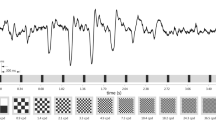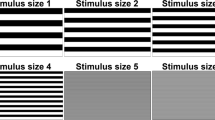Abstract
• Background: We compared the vision objectively assessed by spatial frequency sweep pattern-reversal visual-evoked response (SPVER) with the Snellen acuity in patients. • Methods: SPVER acuity and Snellen acuity were measured in 100 patients with various ocular pathologies, including macular diseases, diffuse retinal degeneration, optic nerve diseases, glaucoma, and high myopia. For SPVER, 10 sinusoidally modulated vertical gratings were presented as stimuli. The responses were averaged and displayed through the discrete Fourier transform on the monitor display. The PVER acuity was determined by extrapolating the SPVER amplitude-spatial frequency function to baseline. • Results: Vision ranged from 20/15 to 20/400 with Snellen acuity, and from 20/25 to 20/190 with SPVER. The overall correlation between the two acuities wasr=0.666. The correlation varied fromr=0.895 in eyes with glaucoma tor=0.436 in eyes with optic nerve disease. Seventy-seven eyes (77%) had a visual acuity agreement of within 1.0 octave between the two measurements. • Conclusion: The SPVER acuity and the Snellen acuity correlated to a certain degree. Discrepancies were found in certain diseases, with the highest disparity in patients with optic nerve disease. We conclude that the SPVER is effective in estimating vision objectively, particularly in patients in whom the standard Snellen test is impossible to perform or yields unreliable results.
Similar content being viewed by others
References
Fagan JJ, Yolton R (1985) Theoretical reliability of visual evoked responsebased acuity determinations. Am J Optom Physiol Opt 62: 95–99
Gottlob I, Fendick MG, Guo S (1990) Visual acuity measurements by sweet spatial frequency visual-evoked cortical potentials (VECPs). J Pediatr Ophthalmol Strabismus 27:40–47
Gottlob I, Wizov SS, Odom JV, Reinecke RD (1993) Predicting optotype visual acuity by sweet spatial visualevoked potentials. Clin Vis Sci 8:417–423
Jenkins T, Douthwaite W (1988) An objective VER assessment of visual acuity compared with subjective measures. Am J Optom Physiol Opt 65:957–961
Katsumi O, Hirose T, Sakaue H, Mehta MC, Rosenstein R (1990) Effect of optica] defocus on the steady state pattern reversa] visual-evoked response. Ophthalmic Res 22:383–390
Katsumi O, Kronheim J, Mehta MC, Matsui Y, Tetsuka H (1993) Measuring vision with temporally modulated stripes in infants and children with ROP. Invest Ophthalmol Vis Sci 34:496–502
Katsumi O, Arai M, Wajima R, Denno S, Hirose T (1996) Spatial frequency sweep pattern reversal VER acuity versus Snellen visual acuity: effect of optical defocus. Vision Res 36:903–909
Katsumi O, Wajima R, Mehta MC, Itabashi R, Arai M, Paranhos FRL, Hirose T (1996) Spatial tuning loss of pattern reversal visual evoked response in optic nerve disease. Acta Ophthalmol Scand 74: 171–177
Muller W, Schoeneich H (1989) Relation between visual acuity, refraction, and the pattern reversa] visual evoked potential in aphakia. Ophthalmologica 198:89–94
Norcia AM, Tyler CW (1985) Spatial frequency sweep VEP: visual acuity during the first year of life. Vision Res 25:1399–1408
Ohn Y-H, Katsumi O, Matsui Y, Tetsuka H, Hirose T (1994) Snellen visual acuity versus pattern reversal visual-evoked response acuity in clinical applications. Ophthalmic Res 26:240–252
Raniel Y, Pratt H, Neumann E, Schacham SE (1989) Miniature fiberoptic pattern reversal stimulator for determination of the visual evoked potential threshold: comparison with Snellen acuity. Graefe's Arch Clin Exp Ophthalmol 227:212–215
Regan D (1973) Rapid objective tefraction using evoked brain potentials. Invest Ophthalmol 12: 669–679
Sanders EACM, Volkers ACW, Poel JCV, Van Lith GHM (1987) Visual function and pattern visual evoked response in optic neuritis. Br J Ophthalmol 71:602–608
Simon F, Rassow B (1986) Retinal visual acuity with pattern VEP normal subjects and reproducibility. Graefe's Arch Clin Exp Ophthalmol 224:160–164
Skalka H (1980) Comparison of Snellen acuity, VER acuity and Arden grating scores in macular and optic nerve diseases. Br J Ophthalmol 64:24–29
Spekreijse H (1966) Analysis of EEG responses in response in man evoked by sine wave modulated light, Junk, The Hague, 129–140
Tyler CW, Apkarian P, Levi DM (1979) Rapid assessment of visual function: an e]ectronic sweep technique with pattern visual evoked potential. Invest Ophthalmol Vis Sci 18:703–713
Author information
Authors and Affiliations
Rights and permissions
About this article
Cite this article
Arai, M., Katsumi, O., Paranhos, F.R.L. et al. Comparison of Snellen acuity and objective assessment using the spatial frequency sweep PVER. Graefe's Arch Clin Exp Ophthalmol 235, 442–447 (1997). https://doi.org/10.1007/BF00947064
Received:
Revised:
Accepted:
Issue Date:
DOI: https://doi.org/10.1007/BF00947064




